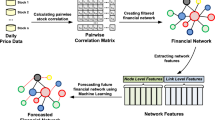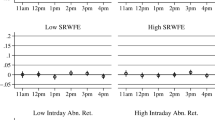Abstract
This study elucidates how the distribution of stock recommendations influences brokerages’ revision strategies and investors’ response to the revisions. We first observe that brokerages tend to adopt mean reverting strategies when their current recommendation distribution deviates too much from their long-term mean buy ratio. However, this process is not straightforward, because brokerages adopt all buy- and sell-type strategies simultaneously. Further, we find that a “mean reverting” strategy for recommendation revisions provokes a less significant reaction from the market. In addition, any revision that enlarges the deviation results in a lower response because of the market’s suspicions of relative optimism or pessimism on the brokerage’s part. We conclude that a steady buy ratio is the best strategy for the brokerage to obtain most effective recommendation returns.


Similar content being viewed by others
Notes
A buy ratio refers to the composition of the buy recommendation contained in the quarterly overall recommendation distribution at the broker level.
Information on analysists research report, prior analyst recommendation literature and analyst recommendation data (mainly I/B/E/S), are merely focus on the sell-side analyst’s behavior (Groysberg et al. 2013; Jung et al. 2018). Roger (2017) points out that “To date, most empirical studies about sell-side financial analysts use the I/B/E/S database”. Therefore we employ the I/B/E/S database as our major source of dataset.
The industry coverage ratio is computed by dividing the number of firms in each industry the broker covered by the total number of companies the brokerage house covered.
Sell recommendations include sell and strong sell recommendations.
The market risk premium (Rm–Rf) is the return on NYSE/AMEX/NASDAQ value-weighted index (Rm) less the U.S. one-month T-bill rate (Rf).
We do not account for dropping the coverage of stocks because brokerages do not ordinarily disclose such news and identifying the exact date when analysts drop the coverage of the stocks is not easy when using I/B/E/S data.
We exclude the period from experience if a lapse of more than 182 days occurs before an analyst issues any forecasts. The experience continues to accumulate until the analyst’s forecasts appear on I/B/E/S.
References
Asquith P, Mikhail MB, Au AS (2005) Information content of equity analyst reports. J Financ Econ 75:245–282. https://doi.org/10.1016/j.jfineco.2004.01.002
Baker M, Wurgler J (2006) Investor sentiment and the cross-section of stock returns. J Finance 61:1645–1680. https://doi.org/10.1111/j.1540-6261.2006.00885.x
Balvers R, Wu Y, Gilliland E (2000) Mean reversion across national stock markets and parametric contrarian investment strategies. J Finance 55:745–772. https://doi.org/10.1111/0022-1082.00225
Barber BM, Lehavy R, McNichols M, Trueman B (2006) Buys, holds, and sells: the distribution of investment banks’ stock ratings and the implications for the profitability of analysts’ recommendations. J Acc Econ 41:87–117. https://doi.org/10.1016/j.jacceco.2005.10.001
Bradley D, Liu X, Pantzalis C (2014) Bucking the trend: the informativeness of analyst contrarian recommendations. Financ Manag 43:391–414. https://doi.org/10.1111/fima.12037
Bradley D, Gokkaya S, Liu X (2017) Before an analyst becomes an analyst: does industry experience matter? J Finance 72:751–792. https://doi.org/10.1111/jofi.12466
Chaiken S, Maheswaran D (1994) Heuristic processing can bias systematic processing: effects of source credibility, argument ambiguity, and task importance on attitude judgment. J Pers Soc Psychol 66:460. https://doi.org/10.1037/0022-3514.66.3.460
Chen YA, Medinets AF, Palmon D (2022) Disclosure regulations work: the case of regulation G. Rev Quant Financ Acc 58:1037–1062. https://doi.org/10.1007/s11156-021-01017-9
Chen CY, Chen KC (2013) Brokers’ stock ratings distributions and the returns from their stock recommendations: evidence Post-NASD Rule2 711. Chinese Academics Accounting Research Conference, Singapore, Research Collection School of Accountancy.
Choudhry T, Dissanaike G, Jayasekera R, Kang WY, Nnadi M (2021) Loss sensitive investors and positively biased analysts in Hong Kong stock market. Rev Quant Financ Acc 57:1345–1371. https://doi.org/10.1007/s11156-021-00980-7
Chu KC, Zhai WH (2021) Distress risk puzzle and analyst forecast optimism. Rev Quant Financ Acc 57:429–460. https://doi.org/10.1007/s11156-020-00950-5
Clement MB (1999) Analyst forecast accuracy: do ability, resources, and portfolio complexity matter? J Acc Econ 27:285–303. https://doi.org/10.1016/S0165-4101(99)00013-0
Coleman B, Drake M, Pacelli J, Twedt B (2022) Brokerage relationships and analyst forecasts: evidence from the protocol for broker recruiting. Rev Acc Stud 1–29. https://doi.org/10.1007/s11142-022-09682-4
Grant A, Jarnecic E, Su M (2015) Asymmetric effects of sell-side analyst optimism and broker market share by clientele. J Financ Mark 24:49–65. https://doi.org/10.1016/j.finmar.2015.04.001
Groysberg B, Healy P, Serafeim G, Shanthikumar D (2013) The stock selection and performance of buy-side analysts. Manag Sci 59:1062–1075. https://doi.org/10.1287/mnsc.1120.1619
Hilary G, Hsu C (2013) Analyst forecast consistency. J Finance 68:271–297. https://doi.org/10.1111/j.1540-6261.2012.01800.x
Hoitash R, Hoitash U, Yezegel A (2021) Can sell-side analysts’ experience, expertise and qualifications help mitigate the adverse effects of accounting reporting complexity? Rev Quant Financ Acc 57:859–897. https://doi.org/10.1007/s11156-021-00963-8
Hsieh WLG, Lee CS (2021) Who reacts to what information in securities analyst reports? Direct evidence from the investor trade imbalance. Pac Basin Financ J 65:101492. https://doi.org/10.1016/j.pacfin.2020.101492
Huang AY, Hu MC, Truong QT (2021) Asymmetrical impacts from overnight returns on stock returns. Rev Quant Financ Acc 56:849–889. https://doi.org/10.1007/s11156-020-00911-y
Huang S, Tan H, Wang X, Yu C (2022) Valuation uncertainty and analysts’ use of DCF models. Rev Acc Stud 1–35. https://doi.org/10.1007/s11142-021-09658-w
Hwang BH, Liberti JM, Sturgess J (2019) Information sharing and spillovers: evidence from financial analysts. Manag Sci 65:3624–3636. https://doi.org/10.1287/mnsc.2017.2986
Irvine PJ (2000) Do analysts generate trade for their firms? Evidence from the Toronto stock exchange. J Acc Econ 30:209–226. https://doi.org/10.1016/S0165-4101(01)00005-2
Irvine PJ (2004) Analysts’ forecasts and brokerage-firm trading. Acc Rev 79:125–149. https://doi.org/10.2308/accr.2004.79.1.125
Jegadeesh N, Kim J, Krische SD, Lee CM (2004) Analyzing the analysts: When do recommendations add value? J Finance 59:1083–1124. https://doi.org/10.1111/j.1540-6261.2004.00657.x
Jung MJ, Wong MF, Zhang XF (2018) Buy-side analysts and earnings conference calls. J Acc Res 56:913–952. https://doi.org/10.1111/1475-679X.12180
Kelly K, Low BM, Tan HT, Tan SK (2012) Investors’ reliance on analysts’ stock recommendations and mitigating mechanisms for potential overreliance. Contemp Acc Res 29:991–1012. https://doi.org/10.1111/j.1911-3846.2011.01138.x
Kim JB, Lu LY, Yu Y (2019) Analyst coverage and expected crash risk: evidence from exogenous changes in analyst coverage. Acc Rev 94:345–364. https://doi.org/10.2308/accr-52280
Kim K, Ryu D, Yu J (2021) Do sentiment trades explain investor overconfidence around analyst recommendation revisions? Res Int Bus Financ 56:101376. https://doi.org/10.1016/j.ribaf.2020.101376
Lehmer T, Lourie B, Shanthikumar D (2022) Brokerage trading volume and analysts’ earnings forecasts: a conflict of interest? Rev Acc Stud 27:441–476. https://doi.org/10.1007/s11142-021-09619-3
Malmendier U, Shanthikumar D (2007) Are small investors naive about incentives? J Financ Econ 85:457–489. https://doi.org/10.1016/j.jfineco.2007.02.001
Mikhail MB, Walther BR, Willis RH (2007) When security analysts talk, who listens? Acc Rev 82:1227–1253. https://doi.org/10.2308/accr.2007.82.5.1227
Morgan J, Stocken PC (2003) An analysis of stock recommendations. RAND J Econ 183–203. https://doi.org/10.2307/3087449
O’Brien PC, McNichols MF, Hsiou-Wei L (2005) Analyst impartiality and investment banking relationships. J Acc Res 43:623–650. https://doi.org/10.1111/j.1475-679X.2005.00184.x
Roger T (2017) Reporting errors in the I/B/E/S earnings forecast database: J. Doe vs. J Doe Financ Res Lett 20:170–176. https://doi.org/10.1016/j.frl.2016.09.026
Stambaugh RF, Yu J, Yuan Y (2012) The short of it: Investor sentiment and anomalies. J Financ Econ 104:288–302. https://doi.org/10.1016/j.jfineco.2011.12.001
Steginga SK, Occhipinti S (2004) The application of the heuristic-systematic processing model to treatment decision making about prostate cancer. Med Decis Making 24:573–583. https://doi.org/10.1177/0272989X04271044
Stephan AP, Walther BR, Wellman LA (2021) Profiting from connections: Do politicians receive stock tips from brokerage houses? J Acc Econ 72:101401. https://doi.org/10.1016/j.jacceco.2021.101401
Yezegel A (2015) Why do analysts revise their stock recommendations after earnings announcements? J Acc Econ 59:163–181. https://doi.org/10.1016/j.jacceco.2015.01.001
Author information
Authors and Affiliations
Corresponding author
Additional information
Publisher's Note
Springer Nature remains neutral with regard to jurisdictional claims in published maps and institutional affiliations.
Rights and permissions
Springer Nature or its licensor (e.g. a society or other partner) holds exclusive rights to this article under a publishing agreement with the author(s) or other rightsholder(s); author self-archiving of the accepted manuscript version of this article is solely governed by the terms of such publishing agreement and applicable law.
About this article
Cite this article
Lo, HC., Chan, CY. Mean reverting in stock ratings distribution. Rev Quant Finan Acc 60, 1065–1097 (2023). https://doi.org/10.1007/s11156-022-01121-4
Accepted:
Published:
Issue Date:
DOI: https://doi.org/10.1007/s11156-022-01121-4




